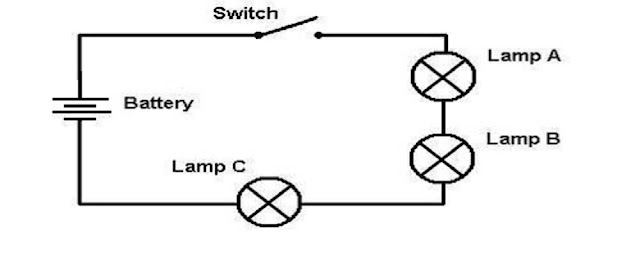Decoding Open Switches in Circuit Diagrams
Ever wondered about those little breaks in lines on a circuit diagram? Those are open switches, silent guardians of electrical flow, and understanding their role is crucial for anyone working with circuits. They might seem simple, but these tiny gaps hold the power to control everything from the lights in your house to complex industrial machinery. So, let's dive into the fascinating world of open switches in circuit diagrams.
A circuit diagram with an open switch represents a state of interrupted current flow. Think of it like a drawbridge: when the bridge is up (switch open), cars (electricity) can’t cross. When the bridge is down (switch closed), traffic flows freely. This simple concept forms the foundation of circuit control. Understanding this fundamental principle allows us to analyze and troubleshoot electrical systems effectively.
While the precise origins of the open switch symbol are difficult to pinpoint, its representation on diagrams evolved alongside the development of electrical engineering itself. Early diagrams likely used more literal depictions, evolving into the standardized symbols we use today. The importance of the open switch lies in its ability to provide control and safety in electrical systems. An open switch prevents power from reaching a component, allowing for isolation during maintenance or preventing accidental operation.
One of the main issues associated with open switches is identifying their status within complex circuits. A seemingly simple open switch can cause a whole system to malfunction. Troubleshooting an open switch involves methodical checking using tools like multimeters to ensure the switch is indeed the culprit and not another component in the circuit.
An open switch, depicted as a gap in a circuit diagram line, signifies a break in the conductive pathway. This interruption stops the flow of electrons, effectively "turning off" the portion of the circuit connected to the switch. A simple example is a light switch: When flipped off (open switch), the light goes out because the circuit powering the bulb is broken.
One benefit of incorporating open switches is safety. By strategically placing open switches, technicians can isolate sections of a circuit for maintenance without risking electrical shock. For example, an open switch in a power distribution panel allows workers to safely work on a specific branch circuit.
Another benefit is control. Open switches provide precise control over the flow of electricity, enabling complex functionalities in devices and systems. Consider a washing machine; multiple open switches control different parts of the wash cycle, activating and deactivating components as needed.
Furthermore, open switches contribute to energy efficiency. By disconnecting unused parts of a circuit, open switches prevent unnecessary energy consumption. This is exemplified by the power button on your computer, which essentially acts as an open switch, cutting power to the internal components when the computer is off.
Troubleshooting an open switch involves a systematic approach. First, visually inspect the switch for obvious damage. Next, use a multimeter to test continuity across the switch terminals. If there’s no continuity when the switch should be closed, the switch is faulty. If the switch tests fine, the problem lies elsewhere in the circuit.
Best practices for incorporating open switches include proper sizing for the current and voltage of the circuit, using appropriate insulation for safety, and ensuring clear labeling on circuit diagrams. Moreover, consider the environment where the switch will operate – factors like humidity and temperature can influence switch selection and longevity.
Real-world examples include light switches in homes, emergency stop buttons on machinery, and the power button on your smartphone. Even the tiny switch in a ballpoint pen uses the same principle of interrupting a circuit to control ink flow.
Advantages and Disadvantages of Open Switches in Circuits
| Advantages | Disadvantages |
|---|---|
| Safety | Potential single point of failure |
| Control | Can be affected by corrosion or wear |
| Energy Efficiency | Troubleshooting can be time-consuming |
A common challenge is switch failure due to wear and tear. The solution involves regular maintenance and replacing faulty switches promptly. Another challenge is ensuring proper switch selection for different applications. Consulting datasheets and understanding the electrical requirements of the circuit helps avoid incompatibility issues.
FAQ: What is an open switch? How does an open switch affect current flow? How do I test an open switch? Why is my circuit not working with an open switch? What are the different types of open switches? How do I choose the right open switch? What are the safety considerations for working with open switches? How can I troubleshoot an open switch problem?
Tips and tricks for working with open switches include using a schematic diagram to understand the circuit layout, utilizing test equipment like multimeters for diagnostics, and always following safety protocols when working with electrical circuits.
In conclusion, the seemingly simple open switch plays a vital role in circuit design and operation. From ensuring safety to enabling complex functionality and promoting energy efficiency, its significance cannot be overstated. Understanding the principles behind open switch operation empowers us to design, analyze, troubleshoot, and maintain electrical systems effectively. By mastering the nuances of open switches, we unlock a deeper understanding of the intricate world of electronics. Remember, an open switch isn’t just a break in a line; it’s a crucial control point that governs the flow of electricity, making our modern world possible. Explore the resources available online and in libraries to further enhance your understanding of circuit diagrams and the crucial role played by open switches. Take the time to practice reading and interpreting circuit diagrams, as this skill is invaluable for anyone working with electrical systems.
Unlocking the warmth of adams gold your benjamin moore guide
Cultivating positivity a guide to seeing the good
Transform your home with sandtex smooth masonry paint white














